
|

|

|

|
BackTristeza1
P.D. Roberts, R.J. McGovern, R.F. Lee and C.L. Niblett 2Tristeza, caused by the citrus tristeza virus (CTV), is one of the most important factors limiting citrus production worldwide. The virus originated in Asia and has spread by man to most citrus producing areas. Devastating epidemics have occurred in the Western Hemisphere beginning with Brazil and Argentina in the 1930s, when both severe CTV strains and the efficient aphid vector, Toxoptera citricida, were introduced by importation of living citrus material. Tristeza-infected citrus was introduced into Florida prior to 1900 but decline was first reported in Florida in the early 1950s. Decline outbreaks were limited at first, but gradually increased, and by the mid 1980s had become widespread and discouraged further use of sour orange rootstock. The epidemic of citrus tristeza virus causing decline (CTV-D) on sour orange rootstock in Florida has increased with the arrival of T. citricida in 1995 and has effectively eliminated sour orange as a rootstock for Florida citrus.
Causal Agent and Epidemiology
Citrus tristeza virus, a member of the closterovirus group, is the largest known plant virus, having the shape of a long flexuous rod about 11 X 2,000 nm in size (Figure 1). The genetic material of the virus consists of a single strand of ribonucleic acid (RNA) which is enclosed by a protein coat. Virus spread occurs through use of CTV-infected budwood and by aphids. CTV is not transmitted in seed, and it is unlikely that it moves in the field on contaminated tools and equipment. Recent molecular studies have allowed complete sequencing of several isolated and have revealed that there are extensive differences among various isolates.
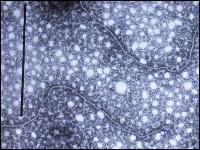
Figure 1. Citrus tristeza virus as seen with a transmission electron microscope after positive staining. The bar indicates 55 nm. CTV is transmitted by several aphid species in a semi-persistent manner. Aphids may acquire the virus after feedings about 10 minutes on infected plants but longer feeding times (up to 24 hours) increase the efficiency of virus transmission. Viruliferous aphids are capable of transmitting CTV for 24 hours after leaving an infected plant. Four aphid vectors of CTV are present in Florida: 1) the melon aphid, Aphis gossypii , which is yellowish-green to blackish-green; 2) the spirea aphid, A. spiraecola , which is light green; 3) the black citrus aphid, Toxoptera aurantti . 4) Toxoptera citricida, commonly called the brown citrus aphid. The black and brown citrus aphids both have brown nymphs and are shiny black as adults. T. citricida can be differentiated from T. aurantti by antennae color and wing veination using a 20x hand lens and is generally more abundant in citrus (Figure 2). T. citricida was first found in Florida in 1995 and has spread rapidly throughout the state. T. citricida is considered the most efficient aphid vector of CTV, about 20 times more effective in transmitting some isolates of CTV under experimental conditions, than A. gossypii , the next most efficient vector. T. citricida is also reported to transmit severe stem pitting CTV strains that are not easily transmissible by the other three aphid vectors. The melon aphid and the BCA differ in biology and this affects the pattern of spread observed.
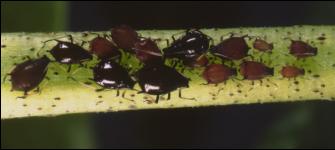
Figure 2. Aphids on Citrus. The risks from stem-pitting CTV strains in Florida have increased with the establishment of T. citricida.
Host Range and Symptoms
CTV infects almost all citrus species, hybrids, and relatives. Many strains of the virus exist and contribute to the diversity of symptoms associated with CTV infection. Mild strains of CTV produce essentially no noticeable symptoms in their hosts. Severe strains produce a range of symptoms including one or more of the following: seedling yellows; decline on sour orange rootstock; stem-pitting of grapefruit; and stem-pitting of sweet orange. The CTV-D strains cause death of the phloem at the bud union. Phloem death produces a girdling effect which may result in overgrowth of the scion at the bud union, paucity of feeder roots, stunting, yellowing of leaves, reduced fruit size, poor growth, dieback, wilting, and death. Declining trees on sour orange rootstock may also exhibit pin holing or honeycombing on the inner face of the bark, or brown discoloration at the bud union. Trees on sour orange exhibiting decline are routinely "pushed" or removed and have to be replaced. Tolerant rootstocks include Carrizo citrange, Cleopatra mandarin, and Swingle citrumelo.However, the other virulent and damaging CTV strains that cause stem-pitting (deep pits in the wood under depressed areas of bark) in scion cultivars and cause stunting and reduced production. Twigs on infected trees are brittle and break easily when intentionally bent or blown by the wind under fruit load. Stem-pitting may not be apparent until the bark is peeled from twigs (Figure 3). Rope-like external symptoms can also be caused by stem-pitting strains in grapefruit tree trunks and/or sweet orange scions (Figures 4, 5). Stem-pitting of scions due to CTV results in decline but does not usually cause tree death. The economic impact of these strains results from reductions in tree size and vigor and reduction in fruit set, size, and quality (Figure 6). Stem-pitting is especially severe in limes and grapefruit, but can affect some sweet oranges. Mandarins are commonly tolerant, but some hybrids are affected. These CTV strains commonly occur in Asia, Australia, Southern Africa, Brazil, Columbia, Venezuela, and other areas.
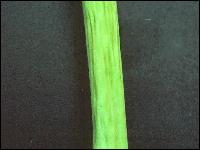
Figure 3. Stem-pitting on small branches of a Pera sweet orange tree in Brazil.
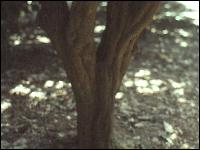
Figure 4. Rope-like external symptoms caused by a stem-pitting CTV strain in the trunk of a grapefruit tree in Australia.
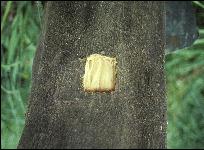
Figure 5. Stem-pitting in a grapefruit tree in South Africa was not obvious until a patch of bark was removed.
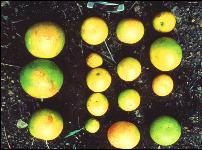
Figure 6. Small fruit from a grapefruit tree infected with a stem-pitting strain of CTV in Columbia. A strain of CTV that causes moderate stem pitting in experimentally inoculated grapefruit was detected in Meyer lemon in Florida but has not been detected in commercial sweet orange or grapefruit plantings. Other imported citrus material may harbor stem pitting CTV strains, but their presence may not be obvious if the introduced material is tolerant to the virus, such as mandarins. There are also reports that stem pitting components may be present in commercial citrus, but are not expressed in mixed infections. Selective movement of such "sleeping" stem pitting strains by T. citricida has been postulated as a future hazard in Florida.
Diagnostic Tests
Mexican lime has been the standard indicator (bioassay plant) used to confirm the presence of CTV. However, it is not useful for differentiation of seedling yellows, decline on sour orange, or stem-pitting components. The enzyme-linked immunosorbent assay (ELISA) is a rapid laboratory test that detects CTV in plant tissue by means of antibodies reactive with the virus. The use of polyclonal antibodies enables detection of all CTV strains. A more selective monoclonal antibody (MLA 13) detects most CTV strains causing decline on sour orange rootstock or stem-pitting and does not react to the mild isolate of CTV common in Florida. However, it does not distinguish Florida decline isolates from stem pitting isolates. Several procedures with potential to more selectively identify specific stem pitting strains have been reported, but none have been sufficiently evaluated to replace biological assays.Currently, differentiation of CTV strains still relies on graft transmission to a battery of bioassay plants including Mexican lime (reactive to most strains), sour orange seedlings (for seedling yellows), a sweet orange scion grafted onto sour orange (for decline), Madam Vinousorange (for stem-pitting on sweet orange), and Duncan grapefruit (for stem-pitting on grapefruit) seedlings). The biological assays for stem-pitting require 10 to 12 months under controlled greenhouse conditions. Once the genetic determinants for specific symptoms are identified it should be possible to construct improved rapid diagnostic essays.
Management
Management strategies for CTV are based on the presence and incidence of the virus and its vectors. Quarantine against importation of citrus except through the DPI citrus germplasm introduction program is important to prevent introduction of new stem-pitting strains. It is also important that no stem pitting strains or other serious citrus disease are disseminated via nursery stock. The Florida Budwood Registration Program maintains and makes available to nurserymen, tested virus-free budwood for use in citrus propagation. Only budwood from trees registered free of severe isolates can be used for propagation. Unfortunately, budwood trees grown outdoors have increased risks of being infected with CTV and are tested yearly for CTV. Trees grown in screenhouses or with other physical barriers that exclude aphids can ensure virus-free budwood. Currently, a few commercial nurseries and two agencies (DPI and the Florida Citrus Foundation) produce virus-free budwood in greenhouses in Florida. Their capacity at present produces only limited quantities of budwood.Removal of declining trees on sour orange and replacement with trees budded on a tolerant rootstock is recommended when a tree is no longer economically viable. Replacement trees should be free of severe isolates or cross-protection with mild strains. Whether to remove and replace the declining trees yearly or to replace an entire block at once is dependent upon each individual situation. The decision must be consistent with the production goals, economic considerations, and management practices of each unique citrus producer.
Suppression and eradication of severe, stem-pitting CTV strains may become important to prevent and delay their distribution in certain situations. Success is based on early detection of infection before it becomes, infested. Production managers and grove workers should constantly monitor trees for infection by stem-pitting strains. Trees exhibiting symptoms of stem-pitting should be reported to DPI in Gainesville for confirmation and appropriate action.
Mild strain cross protection may be implemented immediately to help prolong the economic life of groves which are exposed to severe strains of CTV. Mild strains of CTV have been selected which may slow the damage by severe CTV strains on sour orange rootstocks. However, no mild Florida isolates are known to provide long protection against certain stem-pitting of the virus. Joint research with international scientists indicates that some mild Florida CTV strains may provide cross protection against certain stem-pitting strains of the virus. Intentional introduction of these known and well-characterized mild CTV strains into propagative material would, over a period of several years, result in their widespread prevalence. Proliferation of these mild strains would thus lessen the probability that severe CTV strains could be acquired and transmitted by aphid vectors. The recently recognized genetic diversity among CTV isolates may complicate effective use of cross protection.
Progress is also being made on the introduction of virus resistance into desirable citrus varieties. Immunity to CTV present in Poncirus trifoliata has been transferred into sweet orange type plants suitable for use as breeding parents by conventional plant breeding techniques. In addition, cells of commercial citrus varieties have been fused with CTV-resistant but non-sexually compatible relatives by somatic hybridization. This process provides an approach to utilize resistance genes not previously available in citrus. It also is now possible to genetically change (transform) citrus through the introduction of foreign genes. Such genes, often from the virus itself, have been shown to induce resistance to the virus in the other plants, but so far success has been limited with citrus. While progress is being made in these areas, solutions via this approach are long term. Promising plants must be evaluated for horticultural performance over a number of years before being used on a commercial scale.
Footnotes
1. This document is CH089, one of a series of the Plant Pathology Department, Florida Cooperative Extension Service, Institute of Food and Agricultural Sciences, University of Florida. Original Publication Date:Febuary 1994, please visit the EDIS website at http://edis.ifas.ufl.edu. This publication was formerly PP-174. Date revised October 2001.2. P.D. Roberts, assistant professor, Southwest Florida Research and Education Center, Immokalee, FL., R.J. McGovern, assistant professor, Gulf Coast Research and Education Center, Bradenton, FL., R.F. Lee, professor, Citrus Research and Education Center, Lake Alfred, FL., C.L. Niblett, professor, Citrus Virology, Gainesville, FL. Plant Pathology Department, Cooperative Extension Service, Insitute of Food and Agricultural Sciences, University of Florida, Gainesville, 32611.
The Institute of Food and Agricultural Sciences is an equal opportunity/affirmativeaction employer authorized to provide research, educational information and otherservices only to individuals and institutions that function without regard to racecolor, sex, age, handicap, or national origin. For information on obtaining otherextension publications, contact your county Cooperative Extension Service office.
Florida Cooperative Extension Service / Institute of Food and Agricultural Sciences /University of Florida / Christine Taylor Waddill, Dean
Copyright Information
This document is copyrighted by the University of Florida, Institute of Food and AgriculturalSciences (UF/IFAS) for the people of the State of Florida. UF/IFAS retains all rights under all conventions,but permits free reproduction by all agents and offices of the Cooperative Extension Service and thepeople of the State of Florida. Permission is granted to others to use these materials in part or in fullfor educational purposes, provided that full credit is given to the UF/IFAS, citingthe publication, its source, and date of publication.
NOTE: Page reproduced here with permission granted above. Posted 06 January, 2003, an updated version may exist on the EDIS site.